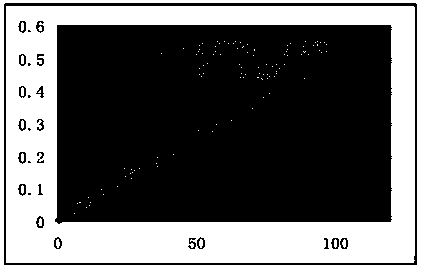Method for detecting specific recombinant human insulin escherichia coli residual host protein
A technology for recombinant human insulin and human insulin, applied in biological testing, material inspection products, etc., can solve the problems of inapplicable residual host protein detection, poor sensitivity, and measurement results that cannot truly reflect residual host protein
- Summary
- Abstract
- Description
- Claims
- Application Information
AI Technical Summary
Problems solved by technology
Method used
Image
Examples
Embodiment 1
[0094] 1.1 Preparation of Escherichia coli containing the pZRHi-1 plasmid integrated with the human insulin gene:
[0095] 1.1.1 The human proinsulin gene sequence was synthesized by the solid-phase phosphoramidite method, and the human proinsulin gene sequence contained a 5'Cla I and a 3'Hind III site;
[0096] 1.1.2 Add Cla I and Hind III restriction endonuclease 0.005M to 0.01M pZRHi-1 plasmid and 0.01M human proinsulin gene containing a 5'Cla I and a 3'Hind III site respectively, at 37 ℃ for 1 hour, then keep at 60℃ for 10-15 minutes to terminate the reaction; mix the two reaction solutions, add DNA ligase 0.005M, react at 16℃ for 11 hours, and obtain a recombinant plasmid capable of expressing the human insulin gene;
[0097] 1.1.3 Add calcium chloride to the culture medium of Escherichia coli at a ratio of 100:1 (V / W), and then add the recombinant plasmid obtained in the above steps at a ratio of 1:1 (V / V), and place on ice at 4°C Bath (also called a water bath) for 30 ...
Embodiment 2
[0136] 1.1 Preparation of Escherichia coli containing the pZRHi-1 plasmid integrated with the human insulin gene:
[0137] 1.1.1 The human proinsulin gene sequence was synthesized by the solid-phase phosphoramidite method, and the human proinsulin gene sequence contained a 5'Cla I and a 3'Hind III site;
[0138] 1.1.2 Add 0.05M of Cla I and Hind III restriction endonucleases to 0.01M pZRHi-1 plasmid and 0.01M human proinsulin gene containing a 5'Cla I and a 3'Hind III site, respectively. Act at 35°C for 1 hour, then keep at 65°C for 10 minutes to terminate the reaction; mix the two reaction solutions, add DNA ligase 0.005M, and react at 14°C for 10 hours to obtain a recombinant plasmid expressing the human insulin gene;
[0139] Calcium chloride is added to the culture solution of Escherichia coli, and the recombinant plasmid obtained in the above steps is added,
[0140] 1.1.3 Add magnesium sulfate to the culture medium of Escherichia coli at a ratio of 100:1 (V / W), then add...
Embodiment 3
[0179] 1.1 Preparation of Escherichia coli containing the pZRHi-1 plasmid integrated with the human insulin gene:
[0180] 1.1.1 The human proinsulin gene sequence was synthesized by the solid-phase phosphoramidite method, and the human proinsulin gene sequence contained a 5'Cla I and a 3'Hind III site;
[0181] 1.1.2 Add 0.005M Cla I and Hind III restriction enzymes to the 0.01M pZRHi-1 plasmid and the 0.01M human proinsulin gene containing a 5'Cla I and a 3'Hind III site, respectively. Act at 35°C for 1 hour, then keep at 60°C for 12 minutes to terminate the reaction; mix the two reaction solutions, add DNA ligase 0.005M, and react at 18°C for 12 hours to obtain a recombinant plasmid expressing the human insulin gene;
[0182] 1.1.3 Add calcium chloride to the Escherichia coli culture solution at a ratio of 100:1 (V / W), then add the recombinant plasmid obtained in the above steps at a ratio of 1:1 (V / V), and place on ice at 2°C Bath for 25 minutes, then place in a 45°C wa...
PUM
| Property | Measurement | Unit |
|---|---|---|
| correlation coefficient | aaaaa | aaaaa |
Abstract
Description
Claims
Application Information
 Login to View More
Login to View More - R&D
- Intellectual Property
- Life Sciences
- Materials
- Tech Scout
- Unparalleled Data Quality
- Higher Quality Content
- 60% Fewer Hallucinations
Browse by: Latest US Patents, China's latest patents, Technical Efficacy Thesaurus, Application Domain, Technology Topic, Popular Technical Reports.
© 2025 PatSnap. All rights reserved.Legal|Privacy policy|Modern Slavery Act Transparency Statement|Sitemap|About US| Contact US: help@patsnap.com



